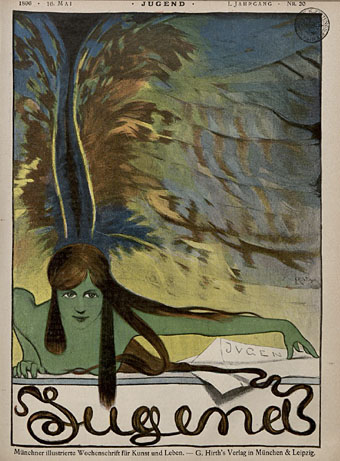
So, then, I’ve now looked through several thousand pages of Jugend magazine and a few things have become apparent. If you’re interested in fin de siècle art and design then all the most interesting material is in the first four years of the magazine’s run, from 1896 on. After 1900 there are still examples of the florid Art Nouveau motifs which filled their earlier pages but the overall style becomes progressively dull, with endless pictures of German towns and hearty country folk. The magazine also begins to reflect an obviously belligerent mood in the country as a whole, pictures of military types and patriotic themes proliferate and the satirical material grows overtly aggressive towards neighbouring nations. Racist cartoons are to be expected—British magazines of the period are much the same—but there’s also a vicious antisemitism boiling away in later issues of Jugend which creates a toxic mix when seen beside the war-mongering on display elsewhere.
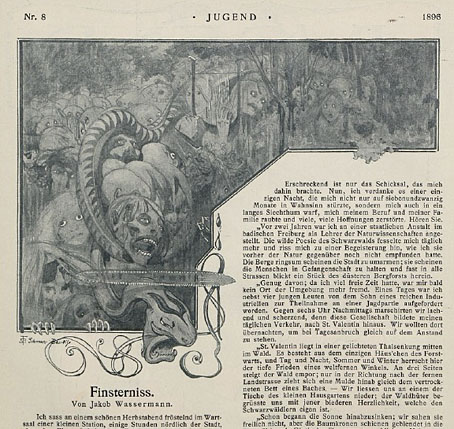
Politics aside, these magazines are still a revelation. Pan magazine was being published at the same time (its entire run is also available in the Heidelberg archives) and is the finer journal if it’s art you’re interested in. But Jugend, being a lighter read, contains a wealth of strange and surprising illustrations. Many are naive or just plain bad, of course, but some are quite remarkable. This is the first of a number of posts I’ll make which highlight illustrations that catch my eye. I’ll also be making some follow-up posts about individual artists as the magazine has been a great introduction to minor illustrators I’ve not come across before. This first post is from the two volumes covering 1896 which can be browsed and downloaded here and here.
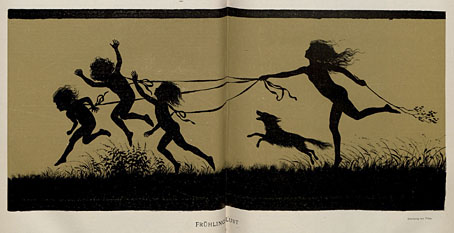
The silhouette is one of many illustrations by Fidus, aka Hugo Höppener (1868–1948), whose obsession with nudity and connections with German naturist groups gained him his nickname when he received a short prison sentence for being nude in public. His clear line work, decorative borders and naturist obsession make his drawings stand out from his contemporaries so it’s unfortunate that his spiritual concerns (he was also a Theosophist) led him towards the Nazis in later years. As Jugend grows more mundane Fidus is one of the few artists to keep the fin de siècle spirit alive.
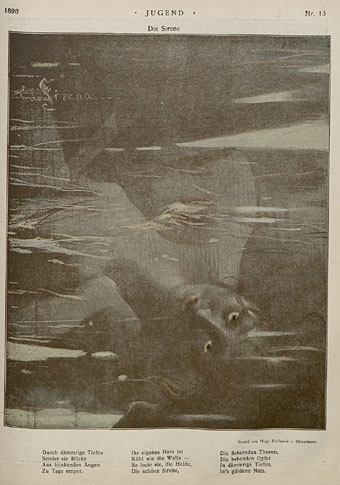
Early issues feature many mermaids and sirens such as this one by Hugo Freiherr von Habermann.
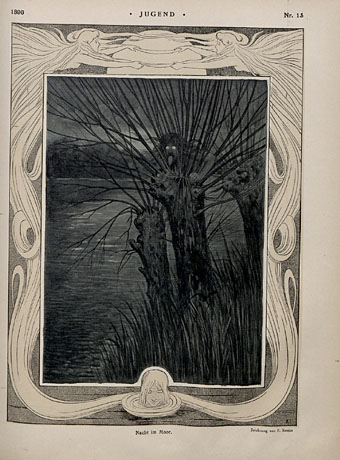

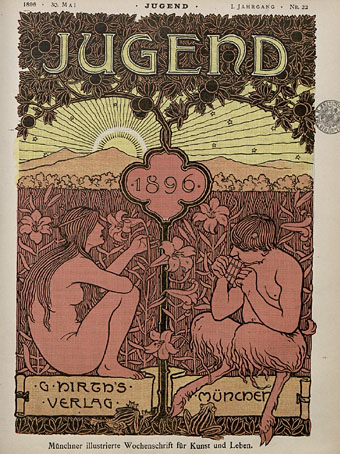
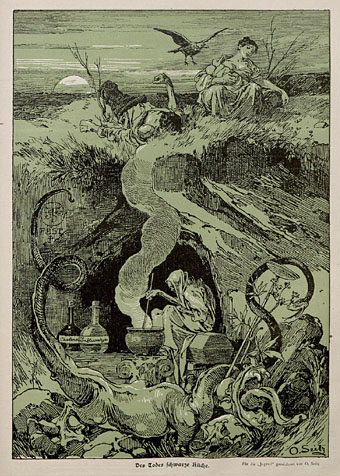
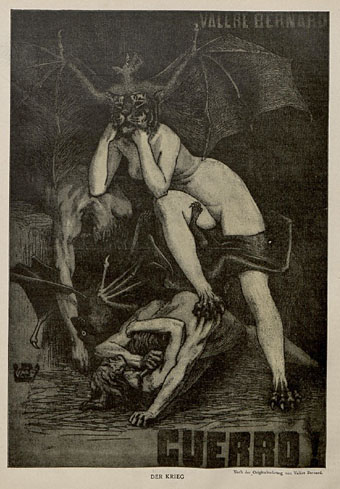
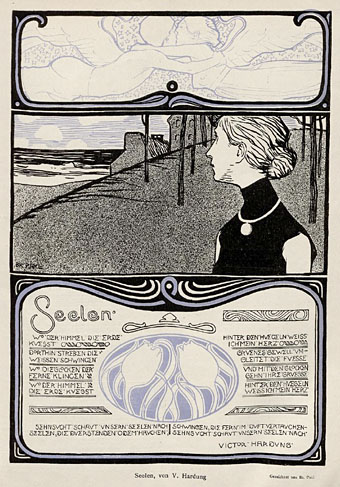
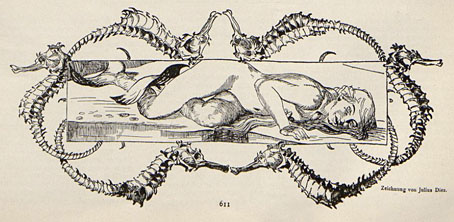
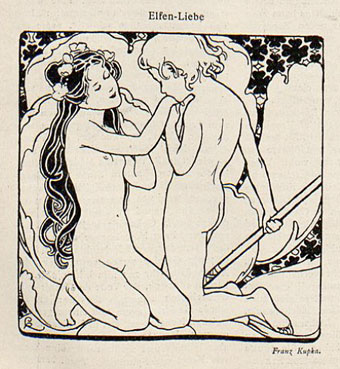
Elfen-Liebe (Elf-Love?). I don’t know whether the Franz Kupka credited here is the Symbolist painter František Kupka but it’s likely given that the Czech artist worked as an illustrator before his paintings gained prominence.
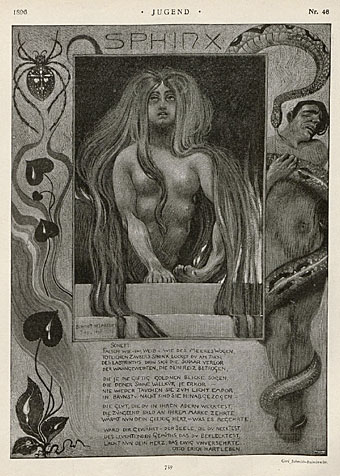
The figures in this drawing are rather bad but it’s worthy of note for being another curious picture by the obscure Carl Schmidt-Helmbrechts whose work has been featured here before.
Elsewhere on { feuilleton }
• The illustrators archive
Previously on { feuilleton }
• Jugend Magazine revisited
• The Great God Pan
• Jugend Magazine
• Empusa
• Kafka and Kupka

How much do I love the tiger-headed and -footed lady? Please, keep the Jugend finds coming.
Shades of Doctor Moreau there, and Wells’ book was also published in 1896. Lots more of this on the way in the next couple of weeks.
Thank you for the links ! Very strange Kupka illustration as it does not look like Kupka work or themes … And you are right, it’s “Elf Love”. I have to look in the books I got about Kupka but I don’t think he lived in Germany, only in Austria then France (and Tchekoslovakia where he was born). I plan to make a comics story with him as character :-)
This is really wonderful stuff; it is unfortunate that it did begin to grow mundane and toxic, because the first four years seem incredible, at least from what I have seen here. I really look forward to your posts on the individual artists.
Li-An: the magazine had a wide range of contributions although the majority are from Germany, of course. They usually credit the city that each artist lived in but not always, as with the mysterious Kupka piece. In the back pages of many early issues they show similar works from artists in other countries, including examples from Beardsley, Will Bradley and Robert Anning Bell.
OK, thank you for these precisions John. But if it’s Kupka’s work, he should be young and not very well known.
Having searched around a bit more I’d feel fairly confident in saying that drawing was indeed our well-known Kupka even though the style is nothing like his paintings. He was 25 in 1896 which isn’t that young–Aubrey Beardsley was dead at that age–and Artcyclopedia has him also known as François and Frank Kupka. Needless to say, if anyone can shed further light on the mystery, I’d like to hear about it.
I have 4 books about Kupka work and did not find anything looking like this drawing. It’s so far from his inspiration that I suspect an error.
Hmm, I’m not so sure. The other alternative is that an artist named Franz Kupka also existed although this seems unlikely.
Another point to consider: the drawing has a signature in the lower left, a K with a long tail and a looped ascender. This matches the similar treatment of the two letter Ks in Kupka’s signature shown here. Whatever the solution, I’ll be looking out now for more Kupka drawings in the later issues!